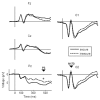Maternal Attachment Representation and Neurophysiological Processing during the Perception of Infants' Emotional Expressions
- PMID: 26862743
- PMCID: PMC4749348
- DOI: 10.1371/journal.pone.0147294
Maternal Attachment Representation and Neurophysiological Processing during the Perception of Infants' Emotional Expressions
Abstract
The perception of infant emotions is an integral part of sensitive caregiving within the mother-child relationship, a maternal ability which develops in mothers during their own attachment history. In this study we address the association between maternal attachment representation and brain activity underlying the perception of infant emotions. Event related potentials (ERPs) of 32 primiparous mothers were assessed during a three stimulus oddball task presenting negative, positive and neutral emotion expressions of infants as target, deviant or standard stimuli. Attachment representation was assessed with the Adult Attachment Interview during pregnancy. Securely attached mothers recognized emotions of infants more accurately than insecurely attached mothers. ERPs yielded amplified N170 amplitudes for insecure mothers when focusing on negative infant emotions. Secure mothers showed enlarged P3 amplitudes to target emotion expressions of infants compared to insecure mothers, especially within conditions with frequent negative infant emotions. In these conditions, P3 latencies were prolonged in insecure mothers. In summary, maternal attachment representation was found associated with brain activity during the perception of infant emotions. This further clarifies psychological mechanisms contributing to maternal sensitivity.
Conflict of interest statement
Figures





Comment in
-
Journal Watch review of Maternal attachment representation and neurophysiological processing during the perception of infants' emotional expressions.J Am Psychoanal Assoc. 2016 Aug;64(4):817-20. doi: 10.1177/0003065116667293. J Am Psychoanal Assoc. 2016. PMID: 27609077 No abstract available.
Similar articles
-
Exploring Associations Between Infant Attachment, Maternal Sensitivity, and Attention to Maternal Emotion Expressions.Dev Sci. 2025 Sep;28(5):e70057. doi: 10.1111/desc.70057. Dev Sci. 2025. PMID: 40741767 Free PMC article.
-
Brain activity during emotion perception: the role of attachment representation.Attach Hum Dev. 2010 May;12(3):231-48. doi: 10.1080/14616731003759724. Attach Hum Dev. 2010. PMID: 20473795
-
Mothers' Neural and Behavioral Responses to Their Infants' Distress Cues: The Role of Secure Base Script Knowledge.Psychol Sci. 2018 Feb;29(2):242-253. doi: 10.1177/0956797617730320. Epub 2017 Nov 14. Psychol Sci. 2018. PMID: 29135364
-
Revisiting the roots of attachment: A review of the biological and psychological effects of maternal skin-to-skin contact and carrying of full-term infants.Infant Behav Dev. 2020 Aug;60:101441. doi: 10.1016/j.infbeh.2020.101441. Epub 2020 Jun 27. Infant Behav Dev. 2020. PMID: 32603951 Review.
-
Behavioral and neural correlates of emotional development: typically developing infants and infants of depressed and/or anxious mothers.J Pediatr (Rio J). 2016 May-Jun;92(3 Suppl 1):S14-22. doi: 10.1016/j.jped.2015.12.004. Epub 2016 Mar 18. J Pediatr (Rio J). 2016. PMID: 26997354 Review.
Cited by
-
The processing of body expressions during emotional scenes: the modulation role of attachment styles.Sci Rep. 2017 Mar 17;7:44740. doi: 10.1038/srep44740. Sci Rep. 2017. PMID: 28303949 Free PMC article.
-
Conceptualizing Emotion Regulation and Coregulation as Family-Level Phenomena.Clin Child Fam Psychol Rev. 2022 Mar;25(1):19-43. doi: 10.1007/s10567-022-00378-4. Epub 2022 Jan 30. Clin Child Fam Psychol Rev. 2022. PMID: 35098427 Free PMC article. Review.
-
A Pilot Study on the Influence of Maternal Attachment Representations on Maternal Heart Rate Mediated by Perceived Stress.Brain Sci. 2024 Apr 23;14(5):412. doi: 10.3390/brainsci14050412. Brain Sci. 2024. PMID: 38790391 Free PMC article.
-
Adult Attachment Styles Associated with Brain Activity in Response to Infant Faces in Nulliparous Women: An Event-Related Potentials Study.Front Psychol. 2017 Apr 21;8:627. doi: 10.3389/fpsyg.2017.00627. eCollection 2017. Front Psychol. 2017. PMID: 28484415 Free PMC article.
-
Racial disparities in EEG research and their implications for our understanding of the maternal brain.Cogn Affect Behav Neurosci. 2023 Feb;23(1):1-16. doi: 10.3758/s13415-022-01040-w. Epub 2022 Nov 22. Cogn Affect Behav Neurosci. 2023. PMID: 36414837 Free PMC article. Review.
References
-
- Bowlby J. Attachment. Volume 1: Attachment and loss. 2nd ed New York: Basic Books; 1969.
-
- Krippl M, Ast-Scheitenberger S, Bovenschen I, Spangler G. Maternal Perception of Infants’ Expressions of Emotion. Journal of Psychophysiology. 2010; 24: 173–185. 10.1027/0269-8803/a000008 - DOI
-
- Ainsworth MD, Blehar MC, Waters E, Wall S. Patterns of attachment A psychological study of the strange situation. Hillsdale, N.J, New York: Lawrence Erlbaum Associates; distributed by Halsted Press Division of Wiley; 1978.
Publication types
MeSH terms
LinkOut - more resources
Full Text Sources
Other Literature Sources
Molecular Biology Databases

